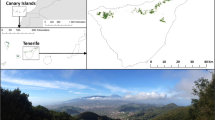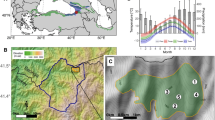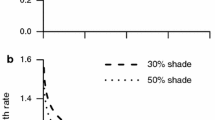Abstract
Our objective was to analyze which factors are critical for the dynamics of terrestrial Asplenium scolopendrium populations at the northern edge of its distribution. Therefore, a long-term study (1978–1999) on the performance and demography of this fern species has been carried out in three different forest stands (Picea sitchensis with Fagus sylvatica, P. sitchensis with thinning, and Fraxinus excelsior) in the Netherlands. We used the recorded demographic data to parameterize 37 transition matrices. The number of frost days in severe winters correlated closely with frond damage and resulted in increased mortality and retrogression. Landslip on the trench banks and intraspecific competition were also found to increase mortality. In the F. excelsior plot, plants grew faster and bigger, produced more fronds and formed a more closed fern cover than in the P. sitchensis stands, likely due to higher light levels. Life-table response experiments revealed that reproduction contributed greatly to the differences in projected population growth rates: reproduction was importantly higher in the F. excelsior and in the thinned P. sitchensis plots than in the P. sitchensis–F. sylvatica plot. These differences can be attributed to an initial difference in light climate and to the accumulation of F. sylvatica litter which reduced recruitment. Recruitment occurred on bare soil but also in open moss carpets. We expect that the fern Asplenium scolopendrium will profit at its northern distribution edge when severe winters will occur less frequently, which is one of the expectations for global climate change.




Similar content being viewed by others
References
Barkham JP (1992) Population dynamics of the wild daffodil (Narcissus pseudonarcissus). IV. Clumps and gaps. J Ecol 80:797–808. doi:10.2307/2260867
Bodziarczyk J (1992) The structure of selected hart’s tongue, Phyllitis scolopendrium (L.) Newm. populations, as related to ecological factors. Ekol Polska 40:439–460
Bremer P (1980) The ferns (Pteridophyta) of the Kuinderbos (The Netherlands): the establishment of 23 species in a planted forest. Acta Bot Neerl 29:351–357
Bremer P (1995) On the ecology and population dynamics of a Dutch population of Polystichum setiferum (Dryopteridaceae: Pteridophyta). Fern Gaz 15:11–20
Bremer P (1999) Mosgemeenschappen op greppelkanten in de Flevolandse bossen. Stratiotes 19:50 (in Dutch with English abstract)
Bremer P (2004) On the ecology and demography of a terrestrial population of Asplenium trichomanes (Aspleniaceae: Pteridophyta) in the Netherlands. Fern Gaz 17:85–96
Bremer P (2007) The colonisation of a former sea-floor by ferns. Dissertation, Wageningen University, Wageningen
Bremer P, Woltjes J, van Hasselt P (1984) Seasonal changes in the phospholipid of the evergreen ferns Phyllitis scolopendrium L. and Asplenium trichomanes L. Abstract of the 4th congress of the federation of European societies of plant physiology, p 317
Bridle JR, Vines TH (2007) Limits to evolution at range margins: when and why does adaptation fail? Trends Ecol Evol 22:140–147. doi:10.1016/j.tree.2006.11.002
Cannell MGR (1990) Effects on plants: forests. In: Cannell MGR, Hooper MD (eds) The greenhouse effect and terrestrial ecosystems of the UK. Institute of Terrestrial Ecology, Natural Environment Research Council, London
Caswell H (2001) Matrix population models. Construction, analysis, and interpretation, vol 2. Sinauer, Sunderland
Cinquemani Kuehn DM, Leopold DJ (1992) Long-term demography of Phyllitis scolopendrium (L.) Newm. var. americana Fern. in central New York. Bull Torrey Bot Club 119:65–76. doi:10.2307/2996921
Cinquemani DM, Faust ME, Leopold DJ (1988) Periodic censuses (1916–1986) of Phyllitis scolopendrium var. americana in central New York State. Am Fern J 78:37–43. doi:10.2307/1547666
Dostál J, Reichstein T, Fraser-Jenkins CR, Kramer KU (1984) Aspleniaceae. In: Kramer KU (ed) Gustav Hegi illustrierte flora von Mitteleuropa Band 1, Teil 1 Pteridophyta. Paul Parey, Berlin, pp 211–275 (in German)
Efron B (1982) The jackknife, the bootstrap and other resampling plans. Society for industrial and applied mathematics, Philadelphia
Ellenberg H (1982) Vegetation Mitteleuropas mit den Alpen in ökologischer Sicht, 3rd edn. Eugen Ulmer, Stuttgart (in German)
Franco M, Silvertown J (2004) A comparative demography of plants based upon elasticities of vital rates. Ecology 85:531–538. doi:10.1890/02-0651
Horvitz C, Schemske DW, Caswell H (1997) The relative “importance” of life-history stages to population growth: prospective and retrospective analyses. In: Tuljapurkar S, Caswell H (eds) Structured-population models in marine, terrestrial and freshwater systems. Chapman and Hall, New York, pp 247–271
Jongejans E, de Kroon H (2005) Space versus time variation in the population dynamics of three co-occurring perennial herbs. J Ecol 93:681–692. doi:10.1111/j.1365-2745.2005.01003.x
Jongejans E, Sheppard AW, Shea K (2006) What controls the population dynamics of the invasive thistle Carduus nutans in its native range? J Appl Ecol 43:877–886. doi:10.1111/j.1365-2664.2006.01228.x
Jongejans E, de Vere N, de Kroon H (2008a) Demographic vulnerability of the clonal and endangered meadow thistle. Plant Ecol 198:225–240. doi:10.1007/s11258-008-9397-y
Jongejans E, Shea K, Skarpaas O, Kelly D, Sheppard AW, Woodburn TL (2008b) Dispersal and demography contributions to population spread of Carduus nutans in its native and invaded ranges. J Ecol 96:687–697. doi:10.1111/j.1365-2745.2008.01367.x
Lehtilä K, Syrjanen K, Leimu R, Garcia MB, Ehrlén J (2006) Habitat change and demography of Primula veris: identification of management targets. Conserv Biol 20:833–843. doi:10.1111/j.1523-1739.2006.00368.x
Lindsay S, Dyer AF (1996) Investigating the phenology of gametophyte development: an experimental approach. In: Camus JM, Gibby M, Johns RJ (eds) Pteridology in perspective. Royal Botanic Gardens, Kew, pp 633–650
Maes B, Bakker P (2002) Evaluatie beschermingsplan Muurplanten: muurplantenbeleid in de periode 1988-2000. Expertisecentrum LNV, Ede (in Dutch)
Økland RH (1997) Population biology of the clonal moss Hylocomium splendens in Norwegian boreal spruce forests. III. Six-year demographic variation in two areas. Lindbergia 22:49–68
Oostermeijer JGB, Brugman ML, de Boer ER, den Nijs HCM (1996) Temporal and spatial variation in the demography of Gentiana pneumonanthe, a rare perennial herb. J Ecol 84:153–166. doi:10.2307/2261351
Page CN (1982) The ferns of Britain and Ireland. Cambridge University Press, Cambridge
Parmesan C, Yohe G (2003) A globally coherent fingerprint of climate change impacts across natural systems. Nature 421:37–42. doi:10.1038/nature01286
Peck JH, Peck CJ, Farrar DR (1990) Influences of life history attributes on formation of local and distant fern populations. Am Fern J 80:126–142. doi:10.2307/1547200
Pfeifer M, Wiegand K, Heinrich W, Jetschke G (2006) Long-term demographic fluctuations in an orchid species driven by weather: implications for conservation planning. J Appl Ecol 43:313–324. doi:10.1111/j.1365-2664.2006.01148.x
Sakai A, Larcher W (eds) (1987) Frost survival of plants: responses and adaptation to freezing stress. Springer, Berlin
Stoutjesdijk P, Barkman JJ (1992) Microclimate vegetation and fauna. Opulus Press, Uppsala
Tamis WLM (2005) Changes in the flora of the Netherlands in the 20th century. Dissertation, Leiden University, Leiden
Tamm CO (1972) Survival and flowering of some perennial herbs. II. The behaviour of some orchids on permanent plots. Oikos 23:23–28. doi:10.2307/3543923
The Nature Conservancy (1990) Element stewardship abstract for Phyllitis scolopendrium var. americana. Minneapolis
Valverde T, Silvertown J (1998) Variation in the demography of a woodland understorey herb (Primula vulgaris) along the forest regeneration cycle: projection matrix analysis. J Ecol 86:545–562. doi:10.1046/j.1365-2745.1998.00280.x
van den Hurk B, Klein Tank A, Lenderink G, van Ulden A, van Oldenborgh GJ, Katsman C, van den Brink H, Keller F, Bessembinder J, Burgers G, Komen G, Hazeleger W, Drijfhout S (2006) KNMI climate change scenarios 2006 for the Netherlands. KNMI, De Bilt, the Netherlands
van Herk CM, Aptroot A, van Dobben HF (2002) Long-term monitoring in the Netherlands suggests that lichens respond to global warming. Lichenologist 34:141–154. doi:10.1006/lich.2002.0378
Weevers T, Heimans J, Danser BH, Kloos AW, van Oostroom SJ, Wachter WH (1948) Flora Neerlandica. Pteridophyta, Gymnospermae. Koninklijke Nederlandse Botanische Vereniging, Amsterdam (in Dutch)
Willems JH, Bik L (1991) Long-term dynamics in a population of Orchis simia in the Netherlands. In: Wells TCE, Willems JH (eds) Population ecology of terrestrial orchids. SPB Academic Publishing, The Hague, pp 33–45
Acknowledgments
The authors thank Joy Burrough for checking the English of the manuscript and the people of Staatsbosbeheer (State Forestry Service) for their cooperation and for executing the thinning experiment. The comments and suggestions of three anonymous referees improved the quality of the manuscript. This research was partly funded by the National Science Foundation (grant DEB-0614065) and Netherlands Organization for Scientific Research (NWO-veni grant 863.08.006).
Author information
Authors and Affiliations
Corresponding author
Rights and permissions
About this article
Cite this article
Bremer, P., Jongejans, E. Frost and forest stand effects on the population dynamics of Asplenium scolopendrium . Popul Ecol 52, 211–222 (2010). https://doi.org/10.1007/s10144-009-0143-7
Received:
Accepted:
Published:
Issue Date:
DOI: https://doi.org/10.1007/s10144-009-0143-7




